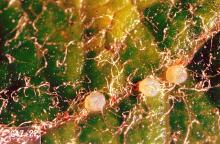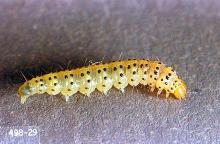Choreutis pariana
Pest description and crop damage Adult moth is reddish brown with a wingspread less than 0.5 inch, and irregular light and dark bands on the wings. Mature larvae are 0.5 inch long, yellowish to greenish, with black spots and a yellow-brown head. The larvae roll and secure leaf edges together then selectively feed on leaf tissues between veins creating a "skeletonized" leaf appearance. They also feed on apple, crabapple, cherry, and hawthorn. Pupae are yellow to brown and found within a white silken cocoon.
Biology and life history Adult moths overwinter in crevices in the tree. They lay eggs in small bunches on the undersides of leaves. The larvae emerge and feed on the undersides of the leaves, then move to the top surface and feed there, often tying the sides together creating a "rolled" effect. There is often more than one caterpillar in the roll and the leaf ends up skeletonized. After 3 to 4 weeks, they pupate in the rolled leaf. Adults emerge after about two weeks to start a new generation. There are at least two generations per year.
Pest monitoring Watch for signs of skeletonizing, which from a distance looks like the leaf tips have been burned.
Management-biological control
There are many natural enemies of this pest. Avoid broad-spectrum sprays that would disrupt populations of these natural enemies.
Management-cultural control
Home orchardists: Larvae and pupae are removed easily from rolled leaves. Remove heavily infested twigs.
Management-chemical control: HOME USE
There are no products registered for control of this pest in home garden plums and prunes.
Management-chemical control: COMMERCIAL USE
Typically, it is not a pest problem in commercial orchards.





